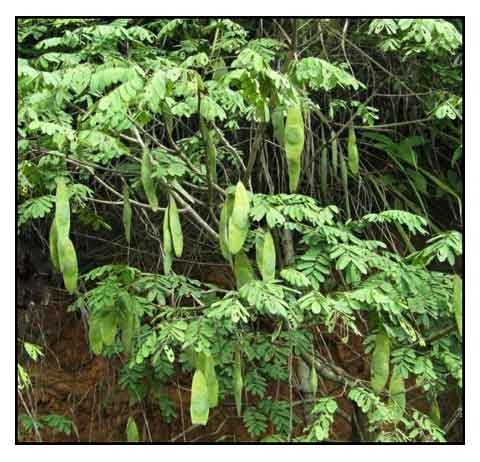 Botany Botany
Balibagan is a climbing shrub reaching a height of several meters. Younger parts are covered with brown hairs, often becoming nearly smooth with age. Leaves are pinnate, 10 to 20 centimeters long, and made up of 15 to 21 leaflets. Leaflets are elliptic-oblong or oblong, 1.5 to 4 centimeters long. Flowers are pink, white, or yellowish, about 5 to 7 centimeters long, and borne in large numbers in axillary and terminal panicles. Pods are oblong to strap-shaped, 3 to 7 centimeters long, and 1.5 centimeters or less wide, and contain 1 to 3 seeds, being thin except where the seeds occur.
Distribution
- In thickets and secondary forests at low and medium altitudes from northern Luzon to Palawan and Mindanao.
- Also occurs in India, Bangladesh, China, Laos, Malaysia, Thailand, Vietnam, Papua New Guinea.
- Occurs in Brazil, Venezuela, French Guiana.
 Constituents Constituents
- Roots and leaves yielded stipulin and luteolin 4'-rutinoside.
- Study of stems isolated two new compounds, dalpulanone (1) and 2-hydroxyisomucronustyrene (2), along with 14 other known compounds (3-16). (see study below) (11)
- Study of crude methanolic extract of roots isolated six known compounds including two pterocarpan derivatives: medicarpin (1) and nitiducarpin (2), two isoflavone derivatives, formononetin (3) and biochanin A (4), and two isoflavone derivatives, nitidulan (5) and dallvelutinane A (6).
(13)
- In a study of four medicinal plants, D. stipulacea showed highest total phenol content with 201.1 ± 0.31 mg GAE/gm, and total highest tannin content with 190.53 ± 0.28 mg.
Flavonoid content was 43.73 ± 1/43 mg CE/gm. (15)
- Phytochemical screening of methanol (M), chloroform (C) and petroleum ether (PE) extracts yielded:
alkaloids (M, C, PE), phytosterol (M, PE), phenol (M. C. PE), tannins (M, PE), flavonoid (<. C, PE), terpenoid (M. C. PE) and glycosides (M, PE), with absence of saponin. (15)
(15)
Properties
- Emmenagogue, abortive, piscicidal, vulnerary.
- Studies have shown antidiarrheal, anthelmintic, anti-inflammatory, anti-arthritic, thrombolytic, antifungal, antibacterial properties.
Parts used
Stem, bark, leaves, roots.
Uses
Folkloric
- Decoction or infusion of the wood and roots used as emmenagogue.
- In excessive doses, used as abortive.
- In Bangladesh, roots and leaves used in gonorrhea and aphthae.
-
Paste made from fruit and leaves applied to wounds and sores.
- In India, bark use to prevent dental cavities. (15)
Others
- Fish poison: Bark and roots used for poisoning fish.
In Nepal, roots used as piscicidal.
- Dental ritual: Plant used by the Maring tribe of Manipur, India, in the age-long tradition of blackening of teeth called Ha-sang. (11)
Studies
• Flavone Glycoside: Study yielded a new luteolin 4′-rutinoside and luteolin from the leaves of Dalbergia stipulacea. (1)
• Antidiarrheal / Anthelmintic / Leaves: Study evaluated a leaf extract for antidiarrheal and anthelmintic activity. At maximum concentration of 400 mg/kg, there was 42.22% inhibition compared to loperamide at 62.23%. Anthelmintic analysis using Panagrellus redivivus worms showed dose dependent activity. At highest dose of 2.5 mg, the extract paralyzed the experimental worm in 5.5 ± 1.323 min, with death in 23.93 ± 1.901 min. (8)
• Anti-Inflammatory / Thrombolytic: Study evaluated methanolic extracts of Dalbergia stipulacea and Hymendictyon excelsium for anti-inflammatory activity by HRBC (human RBC membrane stabilization method), anti-arthritic activity by inhibition of protein denaturation, and antithrombotic activity. Results showed notable anti-inflammatory activity and remarkable anti-arthritic and anti-thrombotic properties. Maximum membrane stabilization of D. stipulacea was 72.33 ±1.32% at a dose of 1000 µg and protein denaturation of 73.50 ± 1.32% at the same dose. Compared to Streptokinase for anti-thrombotic activity, it was close to standard with p<0.001 at 46.79 ±2.43%. (10)
• Antimicrobial / Leaves: Study evaluated the in vitro antimicrobial activity of extracts and isolated compound of Dalbergia stipulacea leaves. N-butanol fractionation yielded a flavonoid glycoside compound, luteolin 4'-rutinoside. Various extracts and isolated compound showed pronounced antibacterial and antifungal activities against four bacteria (Clostridium acetobutylinium, Bacillus subtilis, Streptococcus mutans, and Pseudomonas sp.) and one fungus (Candida albicans). Results suggest an antimicrobial agent with potential application in food, pharmaceutical, and bio-pesticide industries. (12)
• Antifungal / Stems: Study of stems isolated two new compounds, dalpulanone (1) and 2-hydroxyisomucronustyrene (2), along with 14 other known compounds. Compound 4 exhibited the strongest antifungal activity against Pythium insidiosum and had higher activity than standard Amphotericin-B. (see constituents above) (14)
Availability
Wild-crafted.
|

![]()



 Botany
Botany Constituents
Constituents